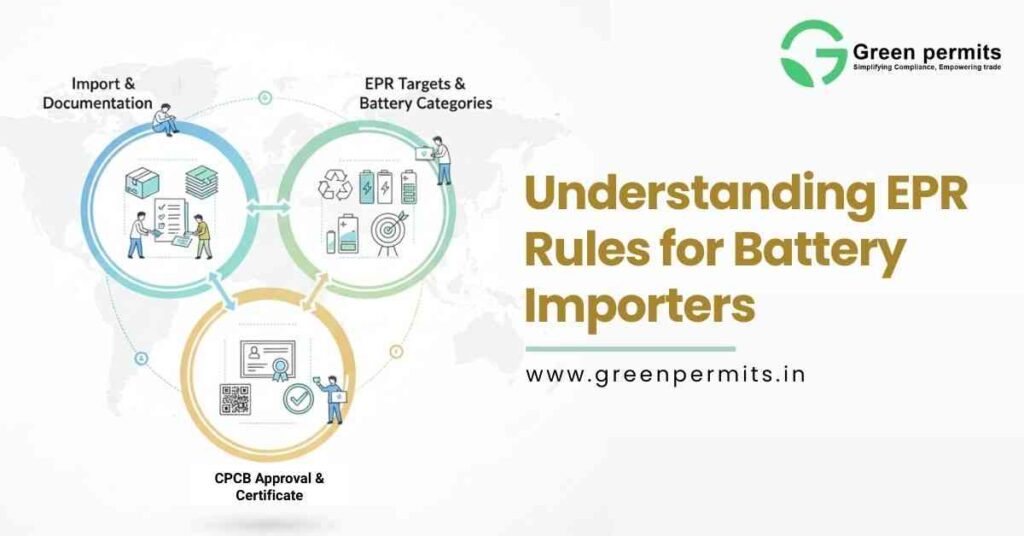- Home
- About Us
- Services
- Blogs
- Be our Partner
- Testimonials
- Contact Us
- Home
- About Us
- Services
- Blogs
- Be our Partner
- Testimonials
- Contact Us
When Rajeev, a small electronics importer from Delhi, received a call from his customs broker saying his shipment was “on hold due to missing EPR details,” he thought it was a minor documentation mismatch. Everything else was in order — IEC, GST, product specs — yet the consignment wouldn’t move.
That moment most importers face eventually: realizing that under India’s Battery Waste Management Rules, importers are treated the same as producers.
If you bring batteries or battery-installed products into the country, the responsibility of end-of-life management sits with you. This guide explains everything an importer needs to know about EPR rules in 2025 — in simple, practical terms.

The 2025 update strengthened responsibilities for companies placing batteries on the Indian market. Importers now have clearer, stricter obligations around traceability, recycling targets, reporting, and labels.
Businesses must now ensure:
Customs authorities have begun enforcing this more aggressively — making EPR a practical requirement, not just a legal one.
You’re considered a “Producer” under the rules if you place batteries or products containing batteries on the Indian market, even if you don’t manufacture them.
If your company name appears in the supply chain, assume you are responsible.
Many importers are unsure how recycling targets are generated. Unlike other compliances, EPR calculations are based on dry-weight of battery material and the metal composition declared in the portal.
Targets increase each year, and the portal automatically calculates the exact amount of each metal for which you must buy recycling certificates.
| Battery Type | FY 2025 | FY 2026 | FY 2027 |
|---|---|---|---|
| Lead-Acid | 50% | 70% | 90% |
| Lithium-Ion | 30% | 50% | 70% |
| Nickel-Cadmium | 40% | 60% | 80% |
| Zinc-Based | 30% | 50% | 70% |
Meaning:
If your company imports 1,000 kg of lithium-ion batteries in FY 2024–25, your obligation for FY 2025–26 is a minimum of 300 kg of recoverable material.
The CPCB portal follows a structured process. Here’s a simplified version tailored for importers.
Create an account and select “Importer” as the producer type.
Provide company identification details and signatory verification.
Enter:
The portal requires annual import data, with weight in kilograms.
You must also upload invoices regularly.
Importers must declare metal composition for each chemistry.
This is critical because incorrect data can lead to scrutiny or rejection.
The portal computes:
You must purchase recycling certificates equivalent to your annual target.
This includes:
Importer Input:
FY 2025 target: 30%
| Metal | Composition % | Total Metal (kg) | Target % | Target (kg) |
|---|---|---|---|---|
| Nickel | 10% | 50 | 30% | 15 |
| Manganese | 8% | 40 | 30% | 12 |
| Cobalt | 12% | 60 | 30% | 18 |
| Iron | 20% | 100 | 30% | 30 |
| Aluminium | 20% | 100 | 30% | 30 |
Total certificates required: 105 kg
Importers must procure this quantity from approved recyclers.
Importers face unique EPR risks because they rely heavily on overseas suppliers. Small details, such as incorrect battery chemistry or weight mismatches, can lead to regulatory issues.
An importer of handheld scanning devices in Bengaluru had a shipment held for nearly a month because the packaging did not display the EPR registration number. Warehousing costs and penalties were significantly higher than the cost of simply staying compliant.
Here are simple steps importers can follow to maintain clean compliance records.
This level of discipline ensures customs clearance remains smooth and predictable.
2025 has made battery EPR compliance unavoidable for importers. Whether you import power banks, electronics, appliances, EV components, or industrial devices, your company now plays a role in India’s battery waste ecosystem. Understanding your responsibilities early — and meeting them properly — saves time, reduces risk, and prevents costly shipment delays.
If you’re unsure about battery categories, targets, or certificate requirements, professional guidance can save you from the kind of surprises that hold up imports at ports.
📞 +91 78350 06182
📧 wecare@greenpermits.in
Book a Consultation with Green Permits
EPR rules require importers to register with CPCB, report annual sales, and meet mandatory recycling/refurbishing targets through certified recyclers.
Yes. Any importer placing batteries or battery-powered equipment in the Indian market must register as a Producer on the CPCB battery EPR portal.
PAN, GST, CIN, IEC, authorized signatory ID, sales data, and relevant compliance documents per CPCB guidelines.
Targets are auto-generated on the portal based on sales history, battery type, and material composition defined under BWM Rules, 2022.
Non-compliance can lead to suspension/cancellation of registration and environmental compensation penalties.